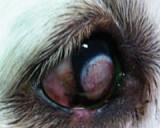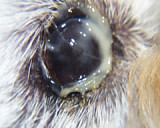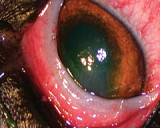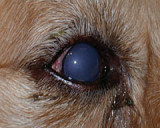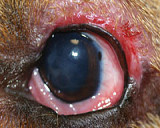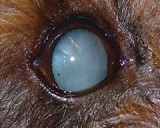Common Eylid conditions in dogs.
Entropion
 Lower lid Entropion is common in many large breed dogs including Labradors, Golden Retrievers, Rottweilers, Standard Poodles and many other breeds with loose skin such as the Shar Pei, Basset Hound and Bulldog. Age of onset is usually 6-18 months old. Surgery is necessary to correct eyelid position to alleviate pain and minimise damage to the cornea. In dogs younger than 20 weeks we will place temporary tacking sutures to evert the eyelids.
Lower lid Entropion is common in many large breed dogs including Labradors, Golden Retrievers, Rottweilers, Standard Poodles and many other breeds with loose skin such as the Shar Pei, Basset Hound and Bulldog. Age of onset is usually 6-18 months old. Surgery is necessary to correct eyelid position to alleviate pain and minimise damage to the cornea. In dogs younger than 20 weeks we will place temporary tacking sutures to evert the eyelids.
This allows time for the growth that may correct the puppy entropion. When surgery is needed most cases of lower lid Entropion require shortening the lower eyelid and then rolling the affected eyelid out.
We have found this combined technique gives us excellent results. Excellent eyelid apposition is essential, so a figure of 8 suture pattern is used to close the eyelid shortening. 5/0 Maxon suture is ideal as it is absorbable, so suture removal is not needed.
Once the eyelid conformation has been restored many entropion cases then require treatment for conjunctivitis.
Distichia
 Extra eyelashes grow right from the eyelid edge out the meibomian gland openings. They are commonly seen in Staffordshire Bull Terriers, Golden Retrievers, Cocker Spaniels and Poodles.
Extra eyelashes grow right from the eyelid edge out the meibomian gland openings. They are commonly seen in Staffordshire Bull Terriers, Golden Retrievers, Cocker Spaniels and Poodles.
Signs may include squinting, watery discharge, conjunctivitis and corneal ulcers. Surgery is required if the distichia are actually causing irritation, our preferred technique involves transconjunctival excision (TCE) of each individual eyelash root. High power magnification is essential. Cryotherapy is preferred with cases of multiple fine lashes and with thin eyelids.
Ectopic Cilia
 Ectopic Cilia are individual eyelid hairs that have grown the wrong way and are directed through the conjunctival side of the eyelid right onto the cornea. They usually cause intense pain and focal ulceration. Ectopic cilia can be extremely hard to see in some cases. Breeds seen with these include Shelties, Poodles and Tibetan spaniels. TCE Surgery is required to remove the hair and the root. Commonly nests of hairs are found.
Ectopic Cilia are individual eyelid hairs that have grown the wrong way and are directed through the conjunctival side of the eyelid right onto the cornea. They usually cause intense pain and focal ulceration. Ectopic cilia can be extremely hard to see in some cases. Breeds seen with these include Shelties, Poodles and Tibetan spaniels. TCE Surgery is required to remove the hair and the root. Commonly nests of hairs are found.
Eyelid Tumour
 Small eyelid tumours that involve less than 40% of the eyelid length can be simply excised with 2-3mm margin. A figure of eight suture with 5/0 Maxon is used to close the defect, followed by simple interrupted sutures. Common small tumours include meibomian gland adenomas, melanocytomas and warty growths. Larger, faster growing tumours require larger margins and reconstructive procedures such as a lip to lid blepharoplasty for large lower lid tumour. Pathology is recommended to determine what type of tumour and if the margins are clean.
Small eyelid tumours that involve less than 40% of the eyelid length can be simply excised with 2-3mm margin. A figure of eight suture with 5/0 Maxon is used to close the defect, followed by simple interrupted sutures. Common small tumours include meibomian gland adenomas, melanocytomas and warty growths. Larger, faster growing tumours require larger margins and reconstructive procedures such as a lip to lid blepharoplasty for large lower lid tumour. Pathology is recommended to determine what type of tumour and if the margins are clean.
